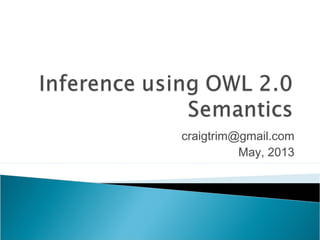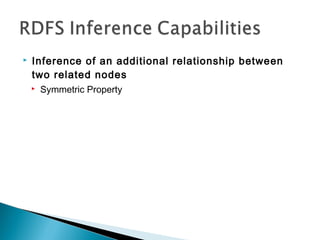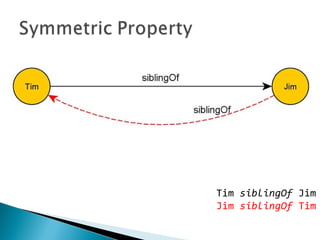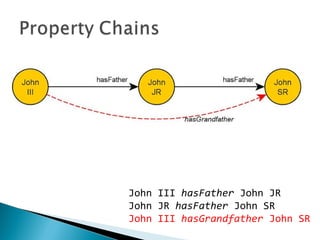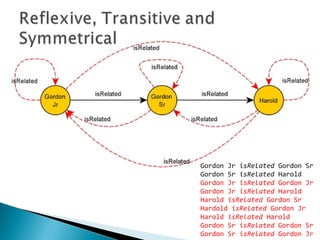Inference using owl 2.0 semantics
- 2. ? A conclusion reached on the basis of evidence and reasoning ? All men are mortal ? Socrates is a man ? Therefore, Socrates is mortal.
- 3. ? Transitive Property ? Functional Property ? Inverse Functional Property ? Symmetric Property ? Asymmetric Property ? Reflexive Property ? Irreflexive Property ? Property Chains
- 4. ? Inference that two nodes are the same ? Functional Property ? Inverse Functional Property
- 5. ? Inference of a relationship between two unrelated nodes ? Transitive Property ? Property Chains
- 6. ? Inference of an additional relationship between two related nodes ? Symmetric Property
- 7. ? Inference of an additional relationship of one node back to itself ? Reflexive Property
- 8. ? Prevents an Inference ? Asymmetric Property ? Irreflexive Property
- 9. Windows?hasVersion?Windows?XP Windows?XP?hasVersion?Windows?XP?SP2 Windows?hasVersion?Windows?XP?SP2
- 10. Bob?Smith?hasMother?Sara?Smith Bob?Smith?hasMother?Sally?Smythe Sara?Smith?owl:sameAs?Sally?Smythe
- 17. power on hasSynonym turn on turn on hasSynonym switch on power on hasSynonym switch on switch on hasSynonym turn on switch on hasSynonym power on turn on hasSynonym power on
- 18. Gordon?Jr?isRelated Gordon?Sr Gordon?Sr?isRelated Harold Gordon?Jr?isRelated Gordon?Jr Gordon?Jr?isRelated Harold Harold?isRelated Gordon?Sr Hardold?isRelated Gordon?Jr Harold?isRelated Harold Gordon?Sr?isRelated Gordon?Sr Gordon?Sr?isRelated Gordon?Jr
- 19. If A is part of B and B is part of C, then A is part of C
- 20. A is part of A
- 21. if A is part of B and A != B then B is not part of A
- 22. 1. OWL 2.0 Primer. 11 Dec 2012. W3C. http://www.w3.org/TR/owl2-primer/ 2. Allemang, Dean; Hender, James. Semantic Web for the Working Ontologist, 2nd Edition. Elsevier, 2011. Book. 3. OWL 2 Web Ontology Language RDF-Based Semantics (Second Edition). 11 Dec 2012. W3C. http://www.w3.org/TR/owl-rdf-based-semantics 4. AsymmetricProperty. 29 April 2009. semanticweb.org. http://owl.semanticweb.org/page/New-Feature-AsymmetricProperty-001- RDFXML 5. Rector, Alan; Welty, Chris. Simple part-whole relations in OWL Ontologies. 11 Aug 2005. W3C. http://www.w3.org/2001/sw/BestPractices/OEP/SimplePartWhole/
Editor's Notes
- In mathematics, a relationship R is said to be transitive if R(a, b) and R(b,c) implies R(a,c). ? The same idea is used for the OWL construct owl:TransitiveProperty. A simple example of a transitive property would be if the Windows Operating System has a version Windows XP, which in turn has a version (or type) of Windows XP SP2, then Windows has version Windows XP SP2. Windows? hasVersion? Windows XP Windows XP? hasVersion? Windows XP SP2 Windows? hasVersion? Windows XP SP2 Because owl:TransitiveProperty is a class of properties, we can assert in our model that a given?property?(such as hasVersion) is a member of the class: ?p? rdf:type? owl:TransitiveProperty :hasVersion? rdf:type? owl:TransitiveProperty From the OWL 2.0 Primer [1] ?(emphasis my own): Now have a look at a property hasAncestor which is meant to link individuals A and B whenever A is a direct descendant of B. Clearly, the property hasParent is a Ī░special caseĪ▒ of hasAncestor and can be defined as a subproperty thereof. Still, it would be nice to "automatically" include parents of parents (and parents of parents of parents). This can be done by defining hasAncestor as?transitive?property.? A transitive property interlinks two individuals A and C ?whenever it interlinks A with B and B with C for some individual B.
- A functional property is one for which there can be just one value. ?Genealogy seems to lend itself here, as it does for many of these examples. ?A person can have just one biological parent, so hasMother (or, more precisely, the sub-property hasBiologicalMother) should be marked functional. ?Likewise, a social security number is (or, should be) unique. ?If two entities have the same social, we can reasonably draw an inference that these two entities refer to the same person. Bob Smith? hasMother? Sara Smith Bob Smith? hasMother? Sally Smythe Sara Smith? owl:sameAs? Sally Smythe The owl:FunctionalProperty provides us with a means of inference that two resources are the same, even if the explicit relationships in our graph might say otherwise. ssn-name? rdf:type? owl:FunctionalProperty I might consider the rdf:type property as a functional property. ?Consider the use of is-a pattern extraction on unstructured data in a corpus. ?The following triples are extracted: Slovakia? rdf:type ?placeSlovakia? rdf:type country Slovakia? rdf:type ?land I might start to infer that (place == country == land) with some degree of confidence. From the OWL 2.0 Primer (emphasis my own): Consider a property? hasHusband . As every person can have only one husband (which we take for granted for the sake of the example), every individual can be linked by the? hasHusband? property to at most one other individual. Note that this statement does not require every individual to have a husband, it just states that there can be no more than one. Moreover, if we additionally had a statement that Mary's husband is James and another that Mary's husband is Jim,? it could be inferred that Jim and James must refer to the same individual.
- The symmetric property is easily understood. As the name suggests, this implies a relationship is bi-directional, even if the relationship was only modeled in one direction. Tim? siblingOf? Jim Jim? siblingOf? Tim From the OWL 2.0 Primer: In some cases, a property and its inverse coincide, or in other words, the direction of a property doesn't matter. For instance the property hasSpouse relates A with B exactly if it relates B with A. For obvious reasons, a property with this characteristic is called symmetric, and it can be specified as follows
- The OWL 2 construct AsymmetricObjectProperty allows it to be asserted that an object property expression is asymmetric - that is if the property expression OPE holds between the individuals x and y, then it cannot hold between y and x. Note that asymmetric is stronger than simply not symmetric.[3, 4]. Stewie? hasParent? Peter Peter? hasParent? Stewie From the OWL 2.0 Primer On the other hand, a property can also be asymmetric meaning that if it connects A with B it never connects B with A. A note was added in the RDF-based semantics rec pointing out that a property being asymmetric is a much stronger notion than its being non-symmetric, and that being symmetric is a much stronger notion than being non-asymmetric.
- In a social network, Peter knows JimBob. ?Use of the reflexive property allows us to cover the obvious case ©C Peter knows Peter and JimBob knows JimBob. Peter? knows ?JimBob Peter? knows ?Peter From the OWL 2.0 Primer: Properties can also be reflexive: such a property relates everything to itself. For the following example, note that everybody has himself as a relative. ?Note that this does not necessarily mean that every two individuals which are related by a reflexive property are identical. ? The reflexive property is used frequently in partonomy: Ī░ car is a part of a carĪ▒ A property P is said to be reflexive when the property must relate individual a to itself. In Figure 4.25 we can see an example of this: using the property knows, an individual George must have a relationship to itself using the property knows. In other words, George must know herself. However, in addition, it is possible for George to know other people; therefore the individual George can have a relationship with individual Simon along the property knows.
- If a property P is irreflexive, it can be described as a property that relates an individual a to individual b, where individual a and individual b are not the same. An example of this would be the property isMotherOf: an individual Alice can be related to individual Bob along the property isMotherOf, but Alice cannot be the mother of herself. Alice isMotherOf Bob Alice isMotherOf Alice From the OWL 2.0 Primer: Properties can furthermore be irreflexive, meaning that no individual can be related to itself by such a role. A typical example is the following which simply states that nobody can be his own parent.
- Property chains are used to relate various categories the father of your father is your grandfather the wife of your brother is your sister-in-law the son of your sister is your nephew This works great for genealogies and I suspect thatĪ»s what it was created for. IĪ»m certain there are other uses to ©C it seems like a convenient property. A property chain is similar to a functor . There's no need to understand functors in order to appreciate the value of this property, but the mathematical parallel is evident. How does this differ from a Transitive property? This is a similar but it involves an additional property being inferred (rather than an extension of the existing relationship). [] rdfs:subPropertyOf hasGrandfather; owl:propertyChain ( hasFather hasFather ). John III hasFather John JR John JR hasFather John SR John III hasGrandfather John SR Also of note this is not limited to just two triple as shown above. A property chain can be enacted over two or more triples triples. Whether a property be enacted over an existing property chain is something I'm not clear about myself. Is this scenario valid? hasGrandfather o hasFather = hasGreatGrandfather IĪ»m not certain myself, but would appreciate insight. From the OWL 2.0 Primer: While the last example from the previous section implied the presence of an hasAncestor property whenever there is a chain of hasParent properties, we might want to be a bit more specific and define, say, a hasGrandparent property instead. Technically, this means that we want hasGrandparent to connect all individuals that are linked by a chain of exactly two hasParent properties. In contrast to the previous hasAncestor example, we do not want hasParent to be a special case of hasGrandparent nor do we want hasGrandparent to refer to great-grandparents etc
- Synonyms can be described as both symmetrical and transitive. power on hasSynonym turn on turn on hasSynonym switch on power on hasSynonym switch on switch on hasSynonym turn on switch on hasSynonym power on turn on hasSynonym power on Using these two properties in conjuction on the hasSynonym predicate creates an explosion of implicit triples. Turn onĪ▒ is set as a synonym for Ī░Power onĪ▒, and Ī░switch onĪ▒ for Ī░turn onĪ▒. Given the predicate properties that are checked here, all of these words are now synonyms of each other. Power on and Switch on have no direct relationship in the explict world, but are related symmetrically via turn on. Note that while a synonym is both transitive and symmetric, an acronym is neither. Digital Video Disc hasAcronym DVD Acronyms are typically not transitive (this would imply there was an acronym that represented an acronym). If the acronym was symmetric, this would the same as saying DVD hasAcronym Digital Video Disc Which would likewise be incorrect. It has been said that there are no exact synonyms in the English language; every variation has a subtle difference in meaning (perhaps given the origins of either Germanic-Saxon, Anglo-Norman or Latin). However, the predicate does not need to reflect this nuance, unless the modeler so chooses.
- We could create a relationship called isRelation and define it as reflexive, transitive and symmetric. Gordon Jr isRelated Gordon Sr Gordon Sr isRelated Harold Gordon Jr isRelated Gordon Jr Gordon Jr isRelated Harold Harold isRelated Gordon Sr Hardold isRelated Gordon Jr Harold isRelated Harold Gordon Sr isRelated Gordon Sr Gordon Sr isRelated Gordon Jr

